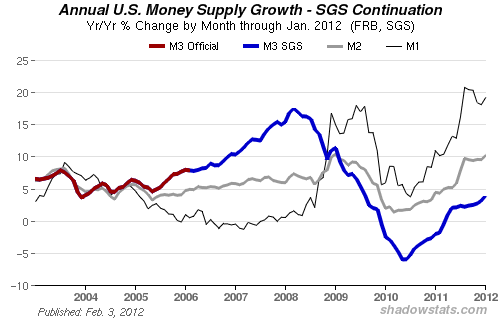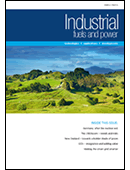Paying up front: the economics of new nuclear build in the US
One of the more eyebrow-raising pieces of news to enter the public domain this month, is the fact that the US government is now offering US$56.5bn in loan guarantees to help jump-start new nuclear build. As a result, now is an opportune time to reflect on the issues surrounding the economics of nuclear power.
A key issue is that given the recent carnage on the financial markets and a move towards greater risk adversity among financiers, investors and lenders, the large up-front costs of nuclear power are more daunting than perhaps they were in the past. A clear sign that lending remains down in the US, is the fact that M3, the broadest definition of money supply, has stopped growing and has in fact started to shrink, as can be seen from the graph below from Shadowstats. In addition, seasonally adjusted total consumer credit on an annual basis averaged -4.0 per cent over the course of 2009, although this did moderate down to -0.8 per cent in December and according to the latest data from the Federal Reserve, outstanding commercial paper remains significantly below where it was in 2008. Although this situation may well improve going forward, it does serve to illustrate the uphill struggle that many companies are experiencing when trying to raise finance.
One major change since the last nuclear build programme took place in the US is that new reactors will have to compete with renewables such as wind and solar power. Although both of these are currently more expensive than conventional power generation, their costs are falling and perhaps more importantly, they are scalable, with much quicker build times. In combination with vastly lower safety and environmental concerns, this means that they offer much less risk to potential investors than nuclear power, especially when one considers the massive cost overruns seen at the Finnish Olkiluoto project, which as of May 2009, was 75 per cent over budget and had seen a doubling in its construction time. An obvious criticism might be that this is an unfair comparison, given the fact that much of the increased costs are the result of the decision to proceed with construction prior to finalising the overall design, but even so, the point stands that this sort of fiasco simply could not occur with renewable equivalents, due to their modular nature.
While the Yucca Mountain repository was extremely expensive and unpopular in many quarters, it would have served to transfer the responsibility of storing nuclear waste from the nuclear industry to the federal government. Given its official demise and the fact that the DoE has increased its budget on fuel cycle research to US$201m, it is clear that nuclear reactor operators will be saddled with their own waste for many years to come. This has important implications in terms of their risk exposure and makes it harder to defend the industry from criticism on environmental grounds.
On the regulatory front, there is the farcical spectacle of large teams of safety experts around the world, all hell-bent on duplicating each other’s work to slightly different criteria. Fortunately, for the US industry, the federal safety review and licensing process in the US has recently streamlined and the Nuclear Regulatory Commission (NRC) has changed its approach. Now it certifies individual reactor designs and also consolidated the licenses need to build and operate a nuclear power station into a single combined construction and operating licence. However, given that a single new nuclear project has yet to break ground, it is hard to assess whether or not the new regime has struck the right balance between speed and rigour.
Crunching the numbers
Getting a real handle on the economics of nuclear power is made difficult by the fact that reliable and recent data concerning the total cost of building a new nuclear plant is notoriously hard to find, with estimates ranging from US$4000/kW as put forward by some utilities to the US$6250/kW proposed by Moody’s Investors Service in mid-June 2009. Some additional light on this subject comes from a March 2008 filing by Progress Energy with the Florida Public Services Commission, in which the utility estimated that the overnight cost for two Westinghouse AP-1000 reactors would be U$5000/kW for the first and US$3300/kW for the second. Once other factors had been considered, this translates into US$8.3bn and US$5.8bn, respectively, a colossal sum by anyone’s standards and an immense risk particularly in the light of the American deregulated electricity market, in which risks have already been largely passed to utilities from consumers.
The issue of cost and build-time gains further urgency in the light of recent estimates from the EIA, which put the overnight cost of an IGCC plant with CCS at just US$3000/kW. This perhaps should be taken with a pinch of salt, given that there is currently not a single full-scale power plant utilising CCS in commercial operation, but at the same time, this raises the question as to just how cheap the technology could become once fully mature.
To be fair, the situation does change markedly, when framed in terms of levelised costs, which take account of capital, fuel and O&M costs. A study by the EIA which has forecasted the average levelised costs (in 2007 US$ values) for plants entering service in 2016, put advanced nuclear firmly ahead of the pack at US$107.3/MWh, above conventional coal (US$94.6/MWh) and CCGT (US$83.9/MWh), but cheaper than renewables and coal or natural gas-fired power plants using CCS. In addition, a recently-updated study by MIT put the levelised cost of nuclear power at US¢8.4/kWh with a risk premium, US¢6.6/KWh without, compared to US¢6.2/kWh and US¢6.65/kWh for coal and natural gas-fired generation. The study made the point that under a US$25/t CO2 regime, the cost of the latter two rose to US¢8.3/kWh and US¢7.5/kWh, respectively. The risk premium attributed to nuclear power is technological and reflects the uncertainities regarding the ability to build the plants on time and on budget, as opposed to reflecting safety or environmental risk. The obvious message from the MIT study is that the higher the price of carbon is, the more competitive nuclear power becomes.
Carbon: the billion dollar question
Unfortunately, while power executives in Europe lament the lack of a stable price signal for carbon emissions, which they see as vital in order to justify the colossal expenditure of new build, their US counterparts lack even a functioning carbon market at the federal level. Given the bitter divisions on this issue in both chambers of the House, not helped by the importance of coal mining to some of the most economically-vulnerable states in the union, some currently believe that such legislation won’t pass until 2011. However, even if it passes this year or had even gone into operation during the Bush administration’s second term of office, a cap-and-trade system would still be unlikely to have matured to the point where utilities could factor it into their decisionmaking. This scenario gains further ground, when you consider that due to the amount of compromise needed to get significant legislation passed in the current political atmosphere, it is easy to see the spectre of over-allocation of carbon credits to major emitters persisting for many years, before such a scheme would start to create a credible price signal for emitting CO2. While there are alternatives to cap-and-trade, given that the very concept of anthropogenically-induced climate change remains a hotly-debated and divisive issue in the US, coupled with concerns regarding the ability of the country’s economy to withstand a carbon “tax” and the fact that cap-and-trade is probably easier to twist in favour of special interest groups than the alternatives, it is very hard to see the US adopting a flat tax on carbon emissions or a cap-and-trade system with a meaningful price floor.
The importance of carbon to the nuclear occasion has recently been underlined by a study entitled “The economic future of nuclear power” which was written by Paul L Joskow and John E Parsons and published in the October 2009 issue of Daedalus. Among its conclusions was the following:
“Absent the imposition of explicit or implicit prices on CO2 emissions, and given the current expected costs of building and operating alternative generating technologies, it does not appear that a large nuclear renaissance will occur based primarily on the economic competitiveness of new nuclear power plants compared to alternative fossil-fuelled base-load generating technologies. It does not appear that new nuclear power plants would be a competitive base-load generating alternative to conventional supercritical coal-fuelled technology, even with high coal prices.”
Why so costly?
In terms of reactor design, steady process has been made, both in terms of safety and optimisation, with particular regard to reducing the number of components, moving towards a more modular approach and the introduction of passive safety features. For example, Westinghouse’s AP1000 pressurised water reactor is designed so that in the event of an accident such as a coolant pipe leak, the plant is designed to undergo and maintain a safe shutdown, even in the absence of operator commands or responsive active components. It also boosts a 60-year design life, an 18-month fuel cycle, which Westinghouse claims, will boost availability and result in lower fuel costs and significantly fewer components than previous designs. GE Hitachi Nuclear Energy’s economic simplified water boiling reactor (ESWBR) also has a range of innovative features and passive safety features. It also involves 25 per cent less pumps, valves and motors, compared to previous nuclear island designs. Both designs according to their manufacturers can be built relatively quickly, the AP1000 in 36 months and the ESBWR in 42.
Unfortunately, these efforts have yet to be shown to reduce the cost of new build. A key issue is the fact that the focus on safety rocketed after the Three Mile Island incident of 1979, leading to a dramatic increase in the specifications required of components. On the positive side, nuclear plant capacity factors, a key determinant in the economics of nuclear power, have risen markedly over the past two decades to around 90 per cent, while the average time to reload fuel has dropped to about 40 days from the 100 required back in 1990. In addition, on an operating cost basis, nuclear power plants do significantly outperform coal-fired power generation or modern CCGTs, but this naturally fails to take account of the vastly higher capital costs of nuclear generation. It should be noted, however, that it is the life-time capacity factor that matters from the point of plant economics and that of the US fleet hovers around 80 per cent.
No Responses
Leave a Reply
Make sure you enter the * required information where indicated.
You must be logged in to post a comment.


 Click here to read the Q4 2011 Issue of Industrial Fuels & Power
Click here to read the Q4 2011 Issue of Industrial Fuels & Power 

